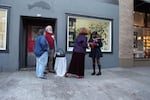
Portland artist and activist Bonnie Meltzer lives near one of the busiest rail intersections in Portland.
Toni Tabora-Roberts
Editor’s Note: Should coal from Wyoming and Montana be transported through the Pacific Northwest and shipped to Asia? In our multimedia project, “Voices of Coal,” we bring you nine diverse perspectives from people across the region with a stake in that debate. Today's installment: The artist-turned-activist.
Artist Bonnie Meltzer lives near one of the busiest rail intersections in Portland. Known as the North Portland Junction, the intersection lies about two miles south of the Washington border. If coal export terminals proposed for Coos Bay and the Port of St. Helens are built, as many as 10 coal trains from the Powder River Basin could travel every day near Meltzer’s home.
Meltzer created an art exhibit to convey her opposition to the coal dust and air pollution coal trains might carry into her neighborhood.
Meltzer has found a unique way to raise awareness about coal’s impact on rail congestion, a concern that has been voiced by residents of other communities along proposed coal train routes.
Coal By The Numbers
- 18 to 20 trains traveled through Oregon's Willamette Valley on an average day in 2012
- Most freight trains in the Northwest are 64- to 112-cars long
- A proposed export terminal in Coos Bay would eventually add two coal trains and two trains of empty cars through the Willamette Valley
- A typical coal train is 125-cars long, spanning 1.3 miles
Source: Oregon Department of Transportation, BST Associates
Click any image below to visit Voices of Coal.




